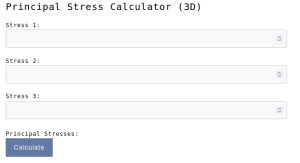Principal Stress Calculator (3D)
Principal Stress Calculator (3D)
Principal Stress Calculator (3D)
A Principal Stress Calculator in 3D is a tool used to determine the principal stresses at a specific point in a three-dimensional stress field. It helps engineers and analysts understand the maximum and minimum stresses acting on a material, which is crucial for assessing its structural integrity and failure criteria. The calculator takes three stress values (σ1, σ2, and σ3) as input and calculates the corresponding principal stresses.
Try out our Payout Ratio Calculator.
Formula:
To calculate the principal stresses in 3D, the following steps are typically followed:
- Calculate the average stress (σ_avg) using the formula: σ_avg = (σ1 + σ2 + σ3) / 3
- Compute the stress deviation (σ_dev) using the formula: σ_dev = √[(σ1 – σ_avg)^2 + (σ2 – σ_avg)^2 + (σ3 – σ_avg)^2]
- Calculate the principal stresses (σ1′, σ2′, σ3′) using the formulas: σ1′ = σ_avg + σ_dev σ2′ = σ_avg σ3′ = σ_avg – σ_dev
The principal stresses represent the maximum, intermediate, and minimum stress values at the point of interest.
Example:
Let’s consider an example to illustrate the use of the principal stress formula in 3D. Assume we have the following stress values:
σ1 = 50 MPa σ2 = 30 MPa σ3 = 20 MPa
Using the Principal Stress Calculator, we input these values:
Stress 1 (σ1): 50 Stress 2 (σ2): 30 Stress 3 (σ3): 20
The calculator then applies the formula:
- Calculate the average stress: σ_avg = (50 + 30 + 20) / 3 = 33.33 MPa
- Compute the stress deviation: σ_dev = √[(50 – 33.33)^2 + (30 – 33.33)^2 + (20 – 33.33)^2] ≈ 14.79 MPa
- Calculate the principal stresses: σ1′ = 33.33 + 14.79 ≈ 48.12 MPa σ2′ = 33.33 MPa σ3′ = 33.33 – 14.79 ≈ 18.54 MPa
Based on this calculation, the principal stresses at the point of interest would be approximately σ1′ = 48.12 MPa, σ2′ = 33.33 MPa, and σ3′ = 18.54 MPa.
FAQs:
- What is the significance of principal stresses in material analysis? Principal stresses provide valuable information about the stress state and failure behavior of a material. They help determine if a material is experiencing tensile or compressive stresses, identify potential failure modes, and assess whether a material is operating within its strength limits.
- Can the principal stress calculator handle negative stress values? Yes, the principal stress calculator can handle both positive and negative stress values. The formula considers the deviation from the average stress, regardless of its sign. However, it’s essential to maintain the correct sign conventions while inputting the stress values to ensure accurate results.
- What if the stress values provided do not follow a specific order? The order of the stress values (σ1, σ2, σ3) does not affect the final result since the calculator calculates the average stress and stress deviation based on the given inputs. However, for consistency, it’s common practice to input the stress values in descending order (σ1 > σ2 > σ3).

Try more calculators:
3D Printing Time Calculator Angles of Parallel Lines With Algebra Calculator Buoyancy Force Calculator
